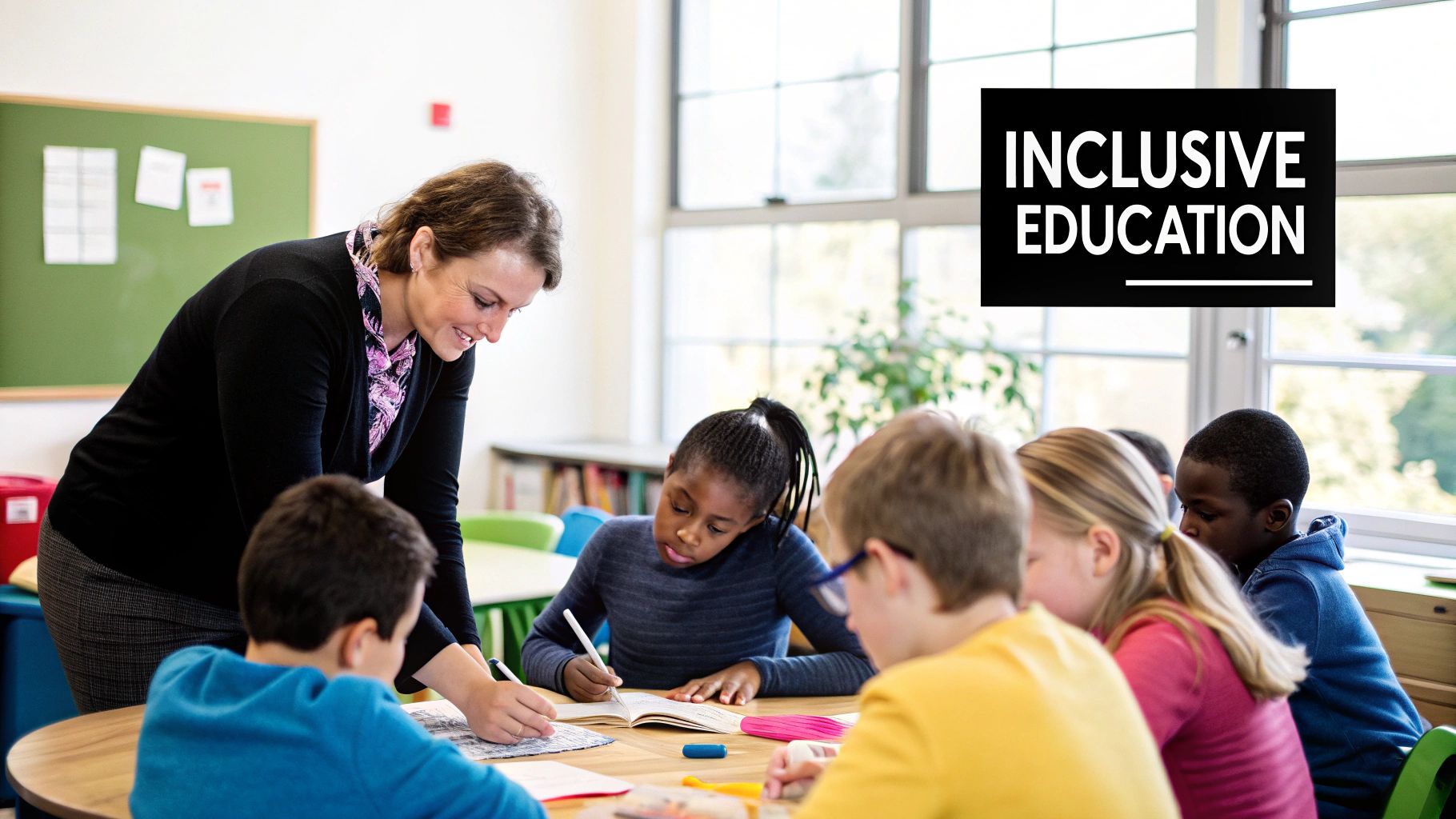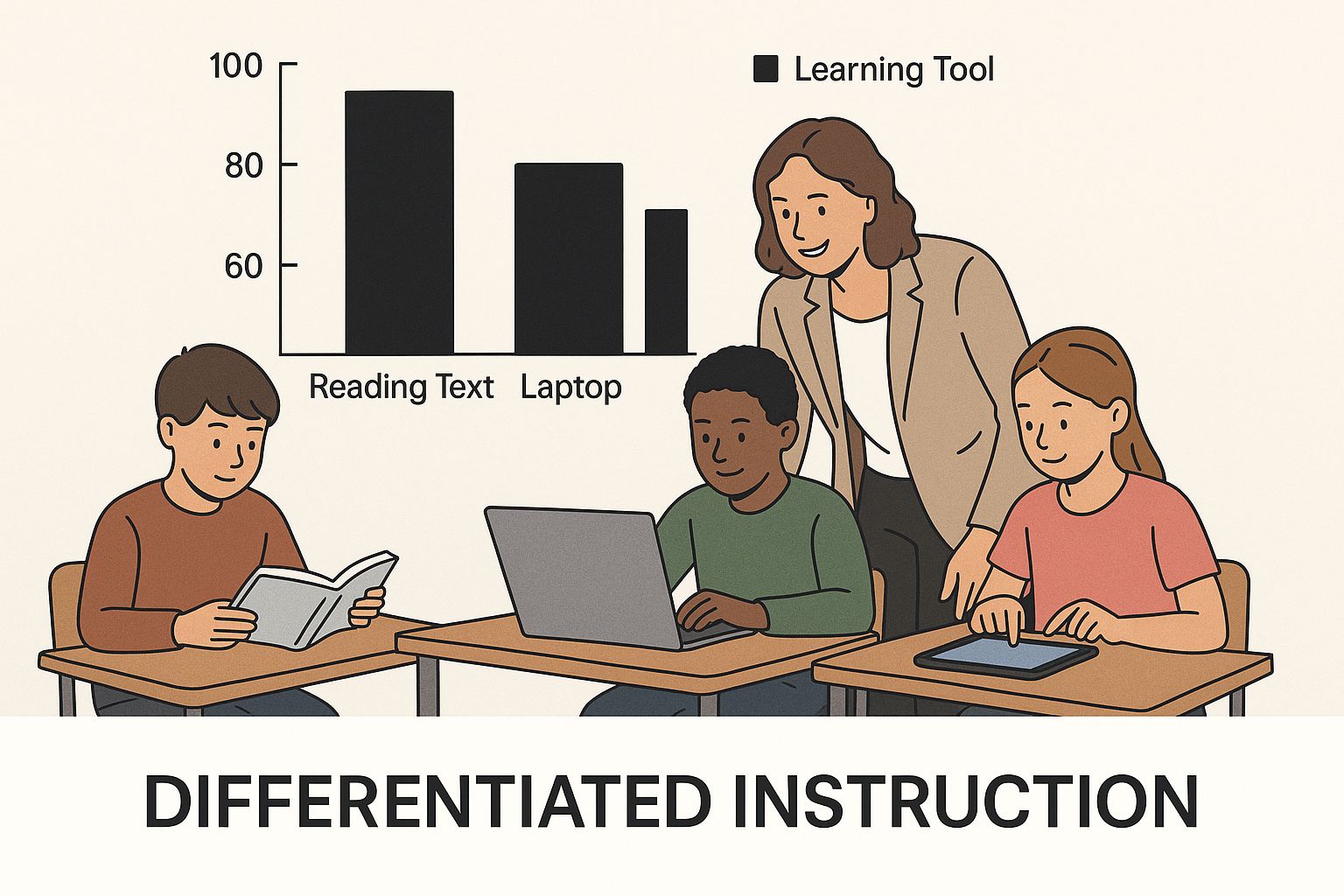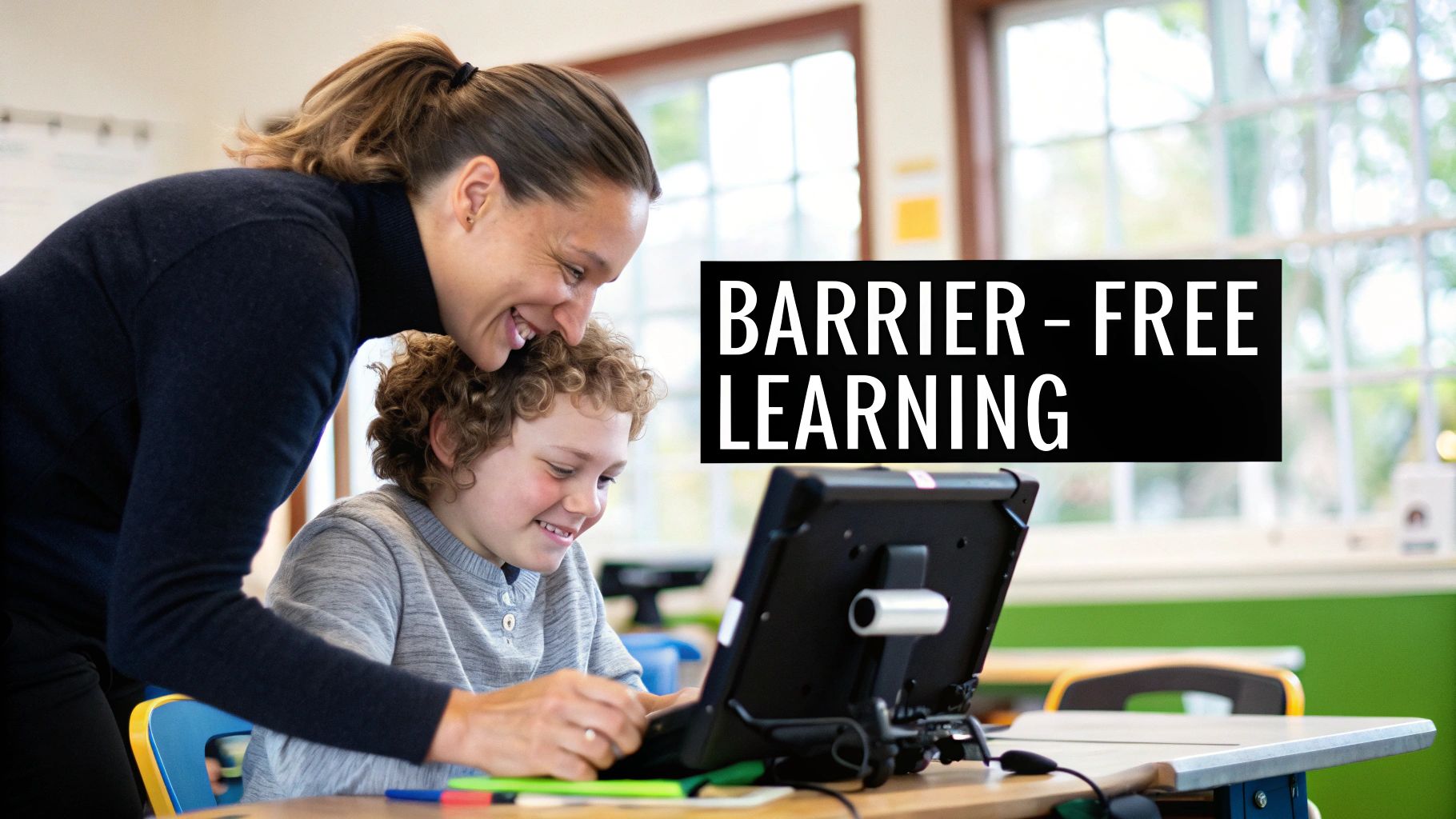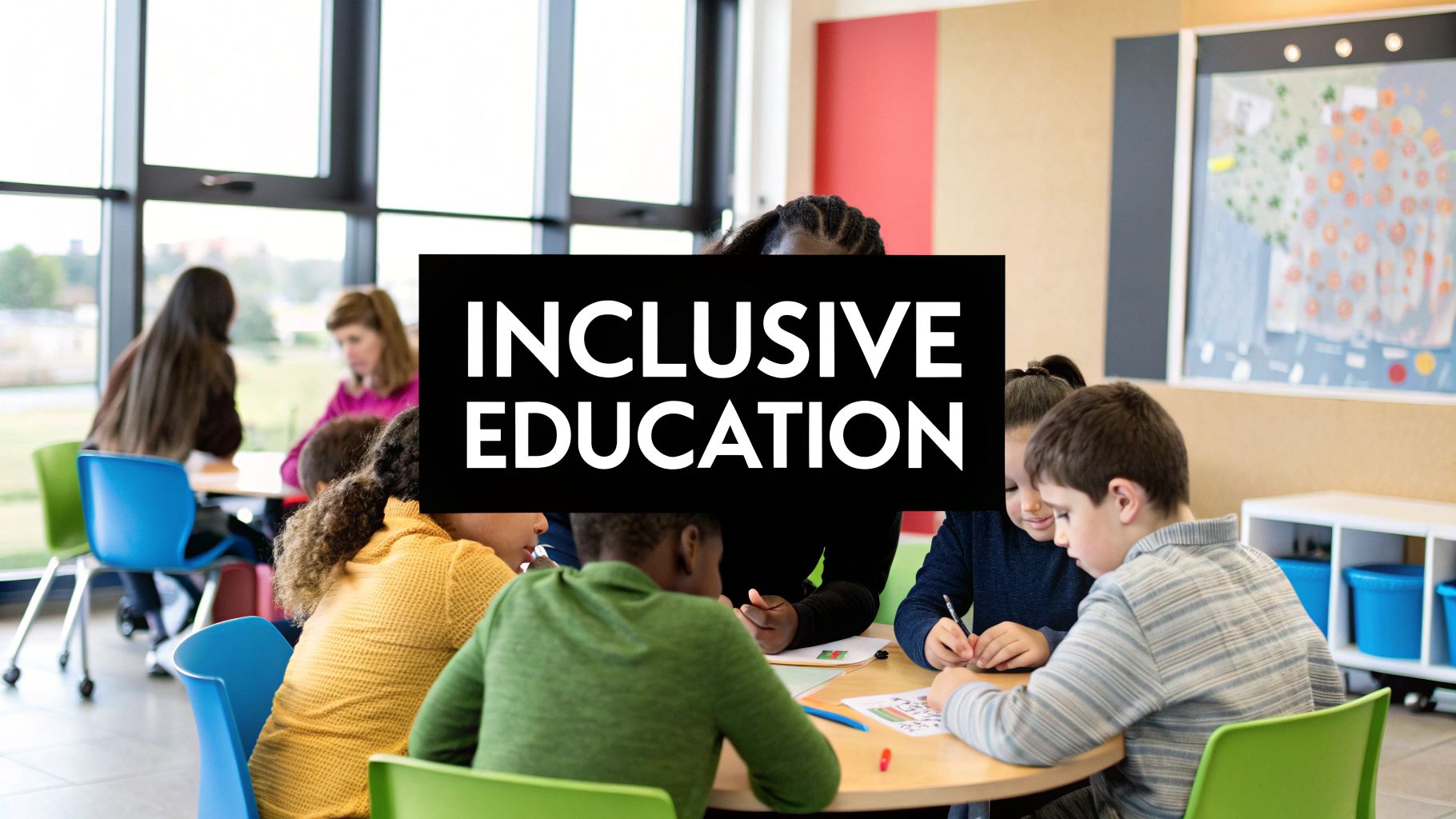Inclusive education isn’t just a policy or a buzzword; it’s a profoundly emotional and powerful idea: that all children learn together in the same classrooms. It’s about looking at every child who walks through the school doors and seeing their unique potential, not a label. This approach makes sure every single child, no matter their ability, background, or learning style, feels truly seen, valued, and supported to reach for their dreams.
Understanding Inclusive Education Beyond the Definition

Think of a classroom less like a factory assembly line and more like a vibrant garden. In this garden, every single plant—whether it’s a resilient sunflower or a delicate fern—gets the unique light, water, and soil it needs to thrive. That’s the real heart of inclusive education. It’s a promise to each child that we see what they need, and we will move mountains to provide it.
It’s a world away from just placing children with different needs into the same room. It’s about fundamentally redesigning the learning environment itself, so every single child feels they belong from the moment they arrive.
A Mindset of Belonging
At its core, inclusion is a mindset built on genuine acceptance and community. It marks the profound difference between a child feeling like a guest who must adapt to fit in, and a child feeling like a cherished family member for whom the home was built.
For instance, imagine a child who finds reading difficult. In a non-inclusive setting, they might be pulled out of class for separate lessons, which can make them feel isolated and different. But in an inclusive classroom, the teacher might bring in audiobooks, create group reading activities where everyone takes a turn in a way they are comfortable, and use visual storyboards. This way, the child learns the exact same material alongside their friends, just in a way that works for them. Their needs are met without them ever having to feel singled out.
Inclusive education is not a strategy to help certain children ‘fit in’ to a pre-existing system. It is about transforming the system itself to be welcoming and responsive to all children.
Putting the Child First
This approach always puts the individual child’s emotional and academic well-being at the centre of every decision. It forces us to ask some powerful questions from the child’s perspective:
- Do I feel safe enough to be myself here?
- Do my teachers and friends understand me and have my back?
- Am I excited to come to school and learn something new?
When we can answer “yes” to these, we see the true magic of inclusion. It’s the look of pure joy on a non-verbal child’s face when they use a tablet to share a brilliant idea, and their classmates listen with genuine respect. It’s the quiet sigh of relief from an anxious child when they’re offered a calm corner to work in.
You can explore more about what inclusion in schools looks like and how it shapes a positive, nurturing atmosphere. This deep commitment to belonging is what helps every single child flourish.
What Are the Foundations of an Inclusive Classroom?
A truly inclusive classroom isn’t just a physical space; it’s a philosophy built on a few powerful, child-centred beliefs. These aren’t abstract ideals discussed in staff meetings. They are the active, foundational principles that shape a learning environment where every single child can flourish.
This mindset shifts the focus entirely. Instead of expecting a child to fit the mould of the classroom, we design a classroom that fits the unique shape of every child. These principles act as our compass, guiding every decision, lesson plan, and interaction to ensure that from the moment a student joins us, they feel secure, valued, and like they truly belong.
Setting High Expectations for Everyone
At the heart of an inclusive classroom is the unwavering belief that every child is capable of great things. This means we move beyond assumptions and labels. We set high, yet genuinely achievable, expectations for every student, regardless of their learning profile. It’s all about seeing potential, not limitations.
For a child who finds traditional maths a struggle, this doesn’t mean we lower the bar. Instead, it means finding a different ladder for them to climb. We might use visual aids, hands-on tools like building blocks to understand fractions, or real-world problem-solving to help them reach the same academic height as their peers. This approach sends a powerful message to that child: “I believe in you.”
Seeing Diversity as a Strength
Inclusion sees the diversity of students not as a challenge to be managed, but as a rich resource that benefits everyone. Each child brings a unique perspective, background, and set of skills that enriches the entire community. It’s about creating a culture where differences aren’t just tolerated but are genuinely celebrated.
An inclusive classroom doesn’t just welcome diversity; it depends on it. The varied experiences of our students are the threads that weave a stronger, more vibrant, and more compassionate learning community.
Designing a Flexible Curriculum
Perhaps the most practical principle is our commitment to a flexible, adaptable curriculum. This is where inclusion truly comes to life. A rigid, one-size-fits-all approach inevitably leaves some children behind, feeling frustrated or disengaged.
Imagine a history lesson on the Roman Empire. Instead of insisting every student writes an essay, a child is given choices that light up their imagination:
- They could build a detailed diorama of the Colosseum.
- They could create an engaging podcast interviewing a “Roman soldier.”
- They could write and perform a short play about daily life in Rome.
All three children are showing their understanding of the topic, but they’re doing it in a way that plays to their personal strengths and interests. This flexibility empowers them to take ownership of their learning, replacing anxiety with the thrill of creation and building confidence with every step.
This approach is more vital than ever, especially given the growing number of children identified with specific needs. In England, about 19.6% of pupils now have a recognised special educational need (SEN). Crucially, the system is designed so that the vast majority—around 73%—are educated within mainstream schools. This makes these flexible, inclusive principles absolutely essential. You can read more about the latest SEN pupil statistics and see just how central inclusion is to the modern education system.
How Every Child Wins in an Inclusive Classroom
There’s a common myth floating around about inclusive education: that it’s really only for children with special educational needs (SEN). While the support is absolutely vital for them, the truth is far more beautiful and profound. A truly inclusive classroom creates an environment where every single child wins. It’s not a zero-sum game where one student’s gain is another’s loss; it’s an expansion of opportunity for all.
For a child with SEN, the advantages are clear and genuinely life-changing. Learning alongside their peers helps them develop crucial social skills that can’t be taught from a textbook, build real confidence, and feel a true sense of belonging. Instead of being isolated, they become part of the natural rhythm of school life, forming friendships and overcoming challenges within a community that supports them.
More Than Just Academics
But what about their classmates? The lessons they learn are just as important, though you might not see them graded on a report card. They gain a deep, practical understanding of empathy, teamwork, and the richness of human diversity. These aren’t abstract concepts anymore; they become lived experiences that shape their character and prepare them for a varied and complex world.
An inclusive classroom teaches the most vital lesson of all: that our differences are not barriers but bridges to new ways of thinking, communicating, and collaborating.
This kind of environment naturally fosters compassion and breaks down the invisible walls of prejudice from a very young age.
A Story of True Collaboration
Picture a group of students working on a history project. One member of the team, a non-verbal student named Leo, uses an assistive tablet to communicate his ideas. At first, some of his classmates aren’t quite sure how to include him effectively.
But during a brainstorming session, Leo uses his device to type out a brilliantly creative idea for their presentation. His classmates watch, fascinated, as his unique perspective completely transforms their project for the better. In that moment, they learn a new way to listen and realise that intelligence and great ideas come in many different forms. Leo feels valued and heard, and his peers learn to appreciate a different, equally valid way of communicating.
This is a small but powerful example of how everyone’s world gets a little bigger in an inclusive setting. The table below breaks down these benefits a bit more.
Benefits of Inclusive Education for Different Learners
| Benefit | Impact on Children with SEN | Impact on All Other Children |
|---|---|---|
| Academic Growth | Higher expectations and access to the full curriculum lead to better academic outcomes. | Deeper understanding of concepts through teaching and explaining to others. |
| Social Skills | Develops communication, friendship-building, and cooperation skills in a natural setting. | Enhances empathy, patience, and leadership skills. Learns to appreciate diversity. |
| Confidence & Belonging | Reduces feelings of isolation and builds self-esteem by being part of the community. | Fosters a welcoming and supportive school culture, reducing prejudice and bullying. |
| Future Readiness | Prepares them for life in a diverse society and workforce. | Develops collaboration skills and a mindset ready for a globalised world. |
Ultimately, the goal is to create a learning environment that works for everyone, not just a select few. The infographic below highlights how differentiated instruction—a cornerstone of inclusive education—makes this possible.

As the image shows, by providing a variety of tools and methods, a teacher can meet the individual needs of every student at the same time. This isn’t about lowering the bar; it’s about giving every child the right ladder to climb, ensuring no one gets left behind. This approach elevates the learning experience for the entire class, not just those who need a specific kind of support.
Practical Strategies for Inclusive Classrooms
Understanding why inclusive education matters is the first step, but bringing it to life in the classroom requires practical, actionable strategies. These aren’t just complex theories; they’re tangible methods that can transform a classroom’s potential into a reality where every child can engage, learn, and feel a true sense of belonging.
The goal is to move beyond simply accommodating differences to actively designing learning experiences that are accessible to everyone from the very start. This means shifting our focus from a single, rigid path of learning to creating multiple pathways to understanding. It’s about honouring the unique way each child thinks and processes information.
Embracing Universal Design for Learning
At the heart of a modern inclusive classroom is Universal Design for Learning (UDL). Think of UDL as building an accessible ramp alongside the stairs from the very beginning, rather than adding it on as an afterthought. It provides multiple ways for students to engage with material, understand information, and show what they know.
For a child, this is transformative. Imagine a lesson on the solar system:
- Instead of just reading a chapter, students can watch an animated video that brings the planets to life.
- They might hold and examine tactile 3D models of the planets, feeling the craters on the moon.
- Learning could be reinforced with an interactive digital quiz that gives immediate, encouraging feedback.
This multi-faceted approach ensures that whether a child is a visual, auditory, or kinaesthetic learner, the lesson speaks their language. It replaces the anxiety of struggling to keep up with a single method with the excitement of discovery.
Differentiating Instruction to Meet Individual Needs
While UDL sets the stage, differentiated instruction brings personalised support to each child. It acknowledges a simple truth: students in the same class are often at different points in their learning journey. So instead of a one-size-fits-all assignment, the tasks are tailored to meet each student exactly where they are.
In a maths class, this could mean that while everyone is learning about fractions, one child might use physical blocks to grasp the concept, another might solve real-life word problems about sharing a pizza, and a third could be tackling more complex equations. The learning goal is the same, but the path to reaching it is unique. This approach replaces boredom and frustration with a sense of challenge and accomplishment, building confidence with every small success. You can learn more about differentiated learning in our guide and how it empowers every student.
The most effective inclusive strategies are not about lowering standards; they are about providing the right support so every child can rise to meet high expectations.
This tailored support is increasingly vital. The landscape for children with Education, Health and Care Plans (EHCPs) is evolving, reflecting a clear move toward greater inclusion. In 2025, 30.4% of children with EHCPs were in special schools, a notable decrease from 38.6% in 2019.
This shift highlights the growing importance of equipping mainstream classrooms with these practical strategies. You can find more details in the government’s latest report on Education, Health and Care plans. To bolster these efforts, educators can also seek out dedicated resources such as available special education grants for teachers.
Overcoming Common Barriers to Inclusion

Pursuing true inclusion is a journey fuelled by passion, but it’s also one that comes with real, often frustrating, obstacles. To genuinely understand what inclusive education means, we have to be honest about the challenges that schools, teachers, and families face every single day.
Ignoring these barriers does a disservice to the very children we’re trying to support. From systemic issues like inadequate funding to the constant need for more specialised teacher training, the path is rarely smooth. These aren’t just abstract problems; they have a direct and emotional impact on a child’s school experience.
Imagine a student who thrives with one-on-one support and has been promised a dedicated classroom aide to help them navigate their lessons. When that support suddenly vanishes due to budget cuts, the child is left feeling confused, frustrated, and alone. This isn’t just a line item in a budget; it’s a broken promise that can shatter a child’s confidence and trust.
The Human Impact of Systemic Gaps
The pressure on educators is immense. So many teachers are deeply committed to inclusion but find themselves without the resources, training, or time to meet the diverse needs in their classrooms. They work tirelessly to adapt, but a constant lack of support leads to burnout and makes it almost impossible to provide the personalised attention every child deserves.
This strain has real consequences. A recent report from the Centre for Young Lives highlights the sheer scale of the challenge: 40% of young people don’t feel a sense of belonging at school, and an astonishing 32 million days of learning were lost to suspensions and unauthorised absences. These figures lay bare the gaps in the system and the emotional toll on vulnerable learners. You can read the full report on boosting inclusion and opportunity to get the bigger picture.
Acknowledging these struggles is not about admitting defeat. It’s about validating the experiences of every child, parent, and teacher who has faced these hurdles. It is the first, most crucial step toward meaningful change.
Forging a Path Forward
So, how do we move forward? The solution lies in a united effort built on advocacy, community, and a relentless focus on what each child needs.
- Strong Advocacy: Parents and educators must become powerful advocates, demanding the funding and policies that make inclusion a reality. This includes fighting for well-structured support systems, like those outlined in a child’s personal learning plan.
- Community Support: Building a strong network between families, schools, and community organisations creates a vital safety net. It ensures no child or family feels isolated in their struggle.
- Systemic Change: We must continue to push for a fundamental shift in how education is resourced and structured. Inclusion must be a non-negotiable priority, not an afterthought.
Creating a robust, child-centred strategy is key. Understanding the role of planning documents can be a powerful tool for parents; our guide with individualized education plan examples offers practical insights into what effective support really looks like. By working together, we can start turning these barriers into stepping stones.
Your Questions About Inclusive Education, Answered
Thinking about inclusive education naturally brings up questions, especially when it’s about your own child’s future. It’s completely normal to feel a mix of hope and concern. We get it.
Below, we’ve tackled some of the most common and heartfelt questions we hear from parents and teachers. Our goal is to cut through the jargon, address your worries head-on, and offer clear, reassuring answers that always put the child first.
Will My Child with Special Needs Get Lost in a Mainstream Class?
This is one of the biggest fears for parents, and it comes from a place of deep love. You worry that in a busy classroom, your child’s unique needs might get overlooked. But here’s the thing: properly implemented inclusive education is the exact opposite of getting lost. It’s a system designed around personalised attention and support.
Think of it less like being a face in the crowd and more like having a dedicated support crew. This is often guided by a formal plan, like an Individual Education Plan (IEP) or an Education, Health and Care Plan (EHCP). This document isn’t just paperwork; it’s a detailed roadmap for your child’s success, outlining specific adjustments, from extra help from a teaching assistant to the use of specialised learning tools.
The secret ingredient is a strong partnership between you and the school. Through regular, open communication, you and the teachers become a team, working together to make sure your child isn’t just getting by, but truly thriving. In a genuinely inclusive classroom, your child is seen, heard, and supported for exactly who they are.
Does Inclusion Slow Down Learning for Other Students?
This is a stubborn myth, but both research and real-world classroom experience tell a completely different story. When done right, inclusive education doesn’t just benefit one child; it enhances the learning environment for every single student. It doesn’t drag the class down—it lifts everyone up.
To teach a diverse group of learners well, teachers have to get creative. They naturally adopt more flexible and engaging methods. For instance, when a teacher explains a science concept using a hands-on experiment, a video, and a group discussion, it helps all children find a way to connect with the material, not just the student who finds textbooks tricky.
Inclusive classrooms don’t just teach academics; they teach humanity. The daily lessons in empathy, teamwork, and appreciating different perspectives are invaluable skills that prepare every child for a compassionate and successful life.
This collaborative atmosphere also sparks powerful peer-to-peer learning. When one student helps another figure out a tough maths problem, they actually reinforce their own understanding in the process. The social skills gained—like empathy, leadership, and creative problem-solving—are profound assets every child will carry with them for the rest of their lives.
What Is the Difference Between Inclusion and Integration?
These two words are often thrown around as if they mean the same thing, but the philosophies behind them are worlds apart. Understanding the difference is key to seeing what makes a truly supportive school.
- Integration is about placing a child with different needs into an existing mainstream system and expecting them to adapt. The focus is on the child fitting in, almost like being a guest in someone else’s house. The system stays the same.
- Inclusion, on the other hand, is about changing the system to welcome the child. It means the classroom, the curriculum, and the entire school culture are designed from the ground up to be flexible and supportive of everyone.
In an inclusive model, a child’s right to belong isn’t up for debate. It’s not something they have to earn by “keeping up.” The responsibility shifts to the environment to adapt, making sure every child has what they need to feel safe, valued, and ready to learn. It’s the difference between being invited to the party and helping to plan it from the start.
At Queen’s Online School, we believe that education should adapt to the child, not the other way around. Our live, interactive classes and personalised support systems create a genuinely inclusive environment where every student, including those with SEN, is set up to succeed. Discover how our online British curriculum puts your child at the centre of their learning journey.

